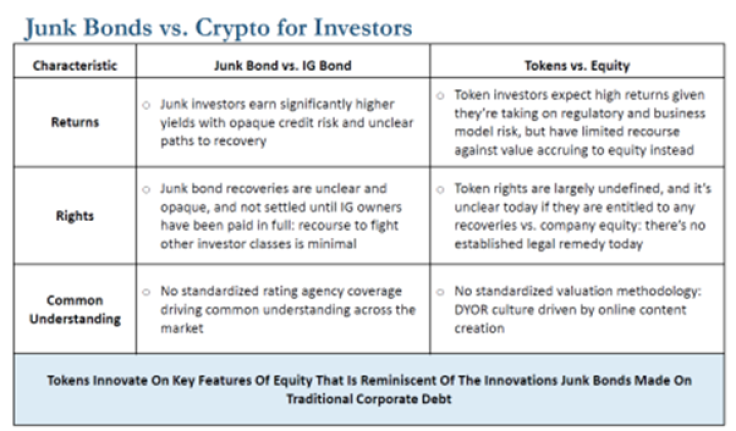
You've undoubtedly heard someone say Crypto is Junk. They probably didn't know the Junk financing market is worth trillions of dollars.
The Crypto world's hatred of financial services is palpable. Call an Aave contributor a banker, and watch the color drain out of their face faster than Sam Bankman-Fried exiting a DeFi bet in November 2021, and understandably so. Crypto was undoubtedly the sexiest discipline of 2021 but risks becoming notorious in light of the ongoing cascade of bankruptcies and failures reminiscent of the 2008 financial crisis. My senior MD once well summarized the burden of notoriety at Goldman:
"Beware when sexy industries become notorious. Banking used to be a no-brainer for anyone trying to live a comfortable life, but the scale of the winnings made it sexy in its day. Poor discipline and a lack of focus led to the industry's catastrophic transition from sexy to notorious. And once you're notorious, you're only going downhill."
Notoriety benefits very few, and token-based cryptoeconomic systems are not among them. Remember that in the short term, markets are driven by social considerations (voting machines). Still, in the long run, they are always dominated by financial considerations (weighing machines), with the fear of missing out obscuring the time horizon. Market performance in 2022 tells us investors took their eye off the ball. Tellingly, the number of Google queries for "What is EBITDA" is up nearly 5x from June last year. I hope those Google-rs got their answer, as it could be a long time before we see a bottom.
Many mental models emerged last year attempting to explain token-based models' explosion and staying power, mostly centered around social capital dynamics. Crypto as money (currency), as utilities (digital commodities), and as branding (NFTs) are all compelling narratives to understand the asset class, though centered primarily around communal dynamics rather than market fundamentals. Some may argue this is purposeful, but each framework avoids SEC attention under the Howey test.
But crypto is, first and foremost, a financial revolution and economic dynamics will drive the future of the industry's valuations. Cultivating suitable financial and mental models will separate winning and losing investors. First, we need to dig into what makes tokens and equity similar:

Using this lens, we can understand crypto as an evolution of corporate equity to a model with more flexibility and risk, less certainty and standardization, and higher expected returns. Said differently, the current business models encourage semi-speculative investment into assets with opaque legal rights and return profiles. While the uninformed may lose their shirt, the diligent will strike digital gold.
Given that financial capital dynamics drive long-run crypto markets, we propose the junk-equity model, which understands the token's role in the capital structure as rights-light equity. Like equity, tokens can capture residual value, but unlike equity, its rights are even more opaque and limited by design. Often, the core source of cash flow is subsidy rewards funded by an inflating token, and investors must depend on token economics underpinned by incentive systems to understand the financial valuation. Understood this way, it's less clear that tokens should be securities. There is less of an expectation of profit than a loose promise of return should the enterprise be successful. Simply put, tokens are skeuomorphic to equity, but there's significantly more uncertainty around what you get.
This isn't the first time new financing instruments have emerged that seem like lite equivalents of the existing ones: the debt market went through a similar revolution in the 80s, and Mike Milken ushered in the era of junk bonds. While the innocuous name junk bond may suggest this was a cordoned niche of the financial services world, junk bonds became a multi-trillion dollar asset class. Milken built his bank Drexel Burnham Lambert into a behemoth with ~$1.5bn of capital in 1988 before it fell apart.
Junk bonds emerged as a small group of clever financiers realized that expanding the Fed's balance sheet from the stagflationary 70s would allow businesses to support riskier debt. This was more obvious to some than others: the whole debt investing industry had emerged around principles of conservatism, and few had dared to push the envelope for fear of increased losses. However, in certain moments of history, circumstance topples even universally held beliefs: the US corporate system could support more leverage than conservative thinkers honed in the 70s could comprehend. In that case, certain factors make the explosion of junk bonds extremely obvious to us in retrospect, including:
1. A balanced budget led to the expansion of the US balance sheet, leading to lower sustained overall yields.
2. Reconstitution of the banking system in the 70s gave borrowers more power
3. The emergence of the "private equity" investor weaponized knowledge of financing markets
Milken's fundamental insight that higher yields compensated for default risk on speculative-grade companies was robust but was amplified significantly by structural innovations of the age, most notably the emergence of collateralized debt structures. The CDO was a new financing structure that multiplied bond demand many-fold, democratizing the diversification benefits of an extensive credit portfolio to a small firm or investor rather than solely the large banks who were the only ones to benefit previously. With it, risky loans could be packaged together and financially engineered to "lower" the headline risk: we know in retrospect the diversification benefit was far lower than advertised given heavy correlations, but it would be years before the ultimate consequences would become apparent. Structure and speculation gave way to true innovation and evolution.
Crypto today shares many characteristics with the junk bond revolution, notably facilitating the bridge between speculation and technological development. Similar to junk bonds, the crypto investment thesis is based on hypotheses that won't be recognized as such for another decade but are startlingly simple:
1. Financial assets are more powerful when they're programmable
2. Automation and communities of motivated users can deliver better margins and asset efficiency
3. Trust-minimizing coordination systems operating at scale increase economic productivity
This revolution comes with its structural evolution: the DAO, which cements decentralized ownership as a business model and supercharges the community's involvement in a protocol. The DAO does a lot to equity tokens, creating skeuomorphic governance rights, cash flow rights, and parameters around control. DAOs bring some structure and predictability to the otherwise lawless crypto jungle, and the intersection of financial and structural innovation drives paradigm shifts.
Crypto and junk bonds share many characteristics beyond encouraging speculation and innovation: they differ from their legacy counterparts in similar ways. In terms of return profile, investor rights, and accepted understanding, tokens strongly match the benefits and shortcomings of junk bonds.

The most important similarity between tokens and junk bonds is that they allow non-standard businesses to flourish, enabled by scaling back elements of standardization and indexation. Financial markets are highly structured, partially driven by legacy difficulties with standard information distribution. SEC filing requirements could be updated to reflect that people can publish online now. The lack of structure and common understanding creates incredibly compelling opportunities for risk-seeking investors to profit from their differentiated knowledge, and the lack of standardization obscures to the rest of the world what might be a common understanding among those in the know. However, companies pursuing this method of junk equity financing should be very wary of Double Leverage. Your token is capitalized on your balance sheet as equity and an asset; it's super sensitive to mark to market. Borrowing against this "asset," a financing liability, provides scope for other market participants to manipulate your asset side of the balance sheet and force your equity negative. The lesson is, if you're asset levered to a market traded asset, DON'T BORROW, or someone external can put you under.
More than one mega alternative asset manager traces their origins to this paradigm of junk financing; notably, Apollo Global Management was founded on the back of Leon Black's use of differentiated underwriting to purchase a book of distressed junk bonds. There was no accepted framework for valuing them, so any actual bid was winning. Leon understood the backdrop that led to the market misunderstanding junk bonds and bought them as quickly as possible. He rode that advantage to build the world's second-largest alternatives manager, with >$500bn+ AUM today and exceptional expertise in credit investing.
Buffet and Graham similarly pioneered investing in businesses based on working capital. What others didn't know in the 1960s was that you could get company balance sheets by going to the SEC offices and trading using that informational advantage. It might feel like a dirty phrase today, but rewards have always been given to people who worked hard to find them in a non-standard world. However, once standardization enters the fray, informational advantages are created by deception rather than grit.
We predict financially inclined token investors will outperform significantly through the next bull market, as only fundamentals can anchor an investor amid the internet's hype machine. When implemented with extreme discipline, financial models provide probabilistic outcomes
analysis with high fidelity. Digging into token inflation models and understanding the scale and longevity of the subsidy is an easy way to rule out bad investments (see: LooksRare). These are just companies with their finger on their lifetime equity financing source.
Mismanagement should be as easy to spot as decisions are recorded on-chain, and markets ruthlessly take projects to zero for unclear value creation. So we've given founders a lot more freedom in letting them control their lifetime financing but instituted a market mechanism for valuation to let markets check wastefulness in real-time. Like Junk bonds, mistakes in token structure are punished swiftly and ruthlessly, as market actors can accrue a controlling share and easily impose their will, as the Ohm protocol did to all its forks during the crash. As Milken did in the 80s, we're ready to give entrepreneurs much leeway to build a generational enterprise. However, founders excited by this new paradigm should be wary that, like the aftermath of the junk bond boom, the crypto boom will also bring classes of financiers weaponizing analysis to profit significantly from pain (see Galios x Luna). And founders won't have the benefit of white shoe lawyers with decades of understanding of institutional structure to bail them out.
Of course, the Junk Equity model isn't suitable for every situation. Tokens like ETH also conform to the crypto is money and crypto is utility models. These mental models aren't mutually exclusive. There are situations in which the junk equity model is more applicable, usually when a company raises equity and token financing. For example, FTX has a free-floating token called FTT. The equity has rights to cash flow, the tokens just to a fee discount, but the token still trades at a ~$10bn diluted cap. Why? Investors are betting that as FTX grows, parts of the business will become decentralized, begin governed by the token, and may accrue cash flow. Many corporate-trained investors will look at the token and pass, but those who understand Sam's vision know he likely will drive value to the token once we have regulatory clarity. The token is option value over the network: it's rights-lightequity.
America's financial history is that of new, efficient emerging markets and savvy financiers using mental models to understand their relevance before the corporate-academic Illuminati arrived to justify it years later. The in-between period is an intense period of higher and often lower lows as the rest of the world picks their side.
But remember, only 4% of the world owns crypto today, and it already feels like that side may be winning. Just imagine what the following billion people will do.







